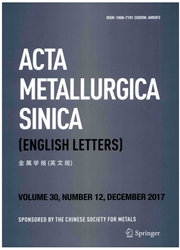

 中文摘要:
中文摘要:
因为 Si 是一在房间温度,非,碳化物形成元素,由铁酸盐组成的多相的微观结构,巴菌体,和保留的奥氏体能被严格地控制 thermomechanical 过程形成。冷却时间表必须被珠泽铁和渗碳体的形成限制。在现在的文章,为微观结构进化的预言的一个新综合数学模型为低碳 Si-Mn 旅行钢的一种典型类型在滚动控制并且冷却控制期间被开发,它由温度模拟,再结晶,和转变模型组成。Si 内容的影响彻底地被调查了。计算结果显示 Si 延迟再结晶,制止奥氏体谷物生长以及加速多角形的铁酸盐转变。
 英文摘要:
英文摘要:
Because Si is a noncarbide forming element, a multiphase microstructure consisting of ferrite, bainite, and retained austenite, at room temperature, can be formed by controlling the thermomechanical process strictly. The cooling schedules must be restricted by the formation of pearlite and cementite. In the present article, a new integrated mathematical model for prediction of microstructure evolution during controlled rolling and controlled cooling is developed for a typical kind of low carbon Si-Mn TRIP steel, which consists of temperature simulation, recrystallization, and transformation models. The influence of Si contents has been thoroughly investigated. The calculated results indicate that Si retards recrystallization, restrains austenite grain growth as well as accelerates polygonal ferrite transformation.
 同期刊论文项目
同期刊论文项目
 同项目期刊论文
同项目期刊论文
 期刊信息
期刊信息
